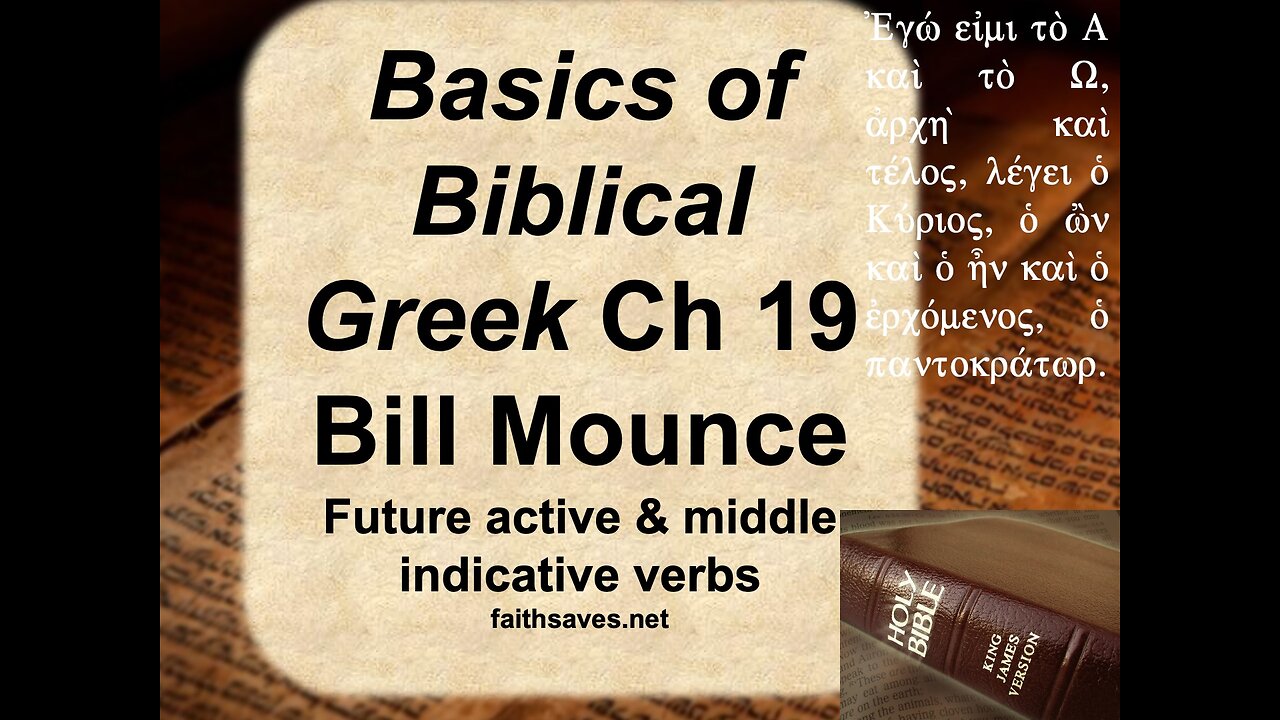Premium Only Content

NT Greek, 1st year, #19: Future Active & Middle Verbs, Basics of Biblical Greek, William Mounce
Chapter 19 of Bill Mounce’s Basics of Biblical Greek covers the Koine Greek future active and future middle indicative. Independent Baptist professor Thomas Ross teaches William Mounce’s textbook.
The Greek future tense indicates an action occurring in the future and is formed by adding a sigma to the end of the future tense stem (λύσω). Contract verbs lengthen their contract vowel before the sigma (ἀγαπήσω). Furthermore, knowing the Square of Stops is especially useful in identifying the future tense.
In the Greek verbal system aspect is generally more important than time. However, for the future tense, one finds almost all the emphasis on time and less of an emphasis upon aspect. Future verbs really talk about future events. Also, of course, the time reference of the verb is from the point of view of the writer, not the reader.
The Greek future active indicative is formed from a future active tense stem (we use a different tense stem for the future than the one employed for the present tense), to which is added something called a tense formative, which for the future is a sigma. After the tense formative we have a connecting vowel—the same ones we have seen already in the present tense, that is, omicron or epsilon. We then have primary active personal endings, that is, the same ones we have already seen in the preset active, so we have no new personal endings to use for the future tense. So for λύω, we tae our future active tense stem, λυ, add to it our tense formative, σ, add to that our connecting vowel, ο/ε, and then add our personal endings (nothing, ς, ι, μεν, τε, νσι). For the 1st person plural future active indicative, for example, that leaves us with λυ + σ + ο + μεν → λύσομεν. The full future paradigm is λύσω, λύσεις, λύσει, λύσομεν, λύσετε, and λύσουσι(ν). These forms mean “I shall loose, thou shalt loose, he/she/it will loose, we shall loose, ye shall loose,” and “they shall loose” respectively.
In the future tense contract verbs lengthen their final stem vowel before the tense formative. Alpha and epsilon both lengthen to eta while omicron lengthens to omega. For example, if we have the α–contract verb ἀγαπάω, to form the 1st person future active indicative 1st person singular we would take the stem *ἀγαπα, to which we would add the tense formative σ and then the 1st person actual ending ω (the actual ending ο lengthened, of course). The final α ending the stem lengthens to η, and we have a resultant form ἀγαπήσω. Similarly with the ε–contract verb ποιέω, we take the stem *ποιε, add the tense formative σ and the 1st person actual ending ω, and, with the final ε of the stem lengthening to η, the resultant form is ποιήσω. With the ο–contract verb πληρόω, we take the stem *πληρο, add the tense formative σ and the 1st person actual ending ω, and with the final ο of the stem lengthening to ω, the resultant form is πληρώσω.
BBG covers the present, the future, the imperfect, the aorist, and the perfect tenses.
Thus, for instance, a lexical entry for λύω first mentions the present active.Right afterwards we see the form λύσω, which is the future active. The form after that is ἔλυσα, the aorist active, followed by the perfect active λέλυκα, the perfect passive λέλυμαι, and the aorist passive ἐλύθην.
These six tense forms are almost universally called “principal parts” in other grammars. BBG/Mounce prefers to speak of “tense forms” rather than “principal parts.”
What is a verbal root? A root is “the most basic form of a word.” The stem of a verb is the “most basic form of a verb in a particular tense.” So we have a present tense stem, a future tense stem, etc. Tense stems are all formed from the root, not from the present tense stem.
The future middle uses the same stem as the future active, but it uses different endings from the future active. To form a future middle, you start with the future active tense stem, add the tense formative σ, add a connecting vowel, but then add primary passive personal endings instead of the primary active personal endings supplied with the future active. The full paradigm is πορεύσομαι, “I will go,” πορεύσῃ, “thou shalt go,” πορεύσεται, “he/she/it will go,” πορευσόμεθα, “we will go,” πορεύσεσθε, “ye shall go,” and πορεύσονται, “they will go.”
εἰμί is a future middle deponent. BBG says that its root is *εσ, and, it takes primary passive personal endings as a future middle. So ἔσομαι means “I will be” (remember the verb is deponent), ἔσῃ means “thou shalt be,” ἔσται means “he/she/it will be” (note that there is no connecting vowel in the 3rd person future tense form. In other words, the form is ἔσται, not ἔσεται.); ἐσόμεθα means “we will be,” ἔσεσθε means “ye shall be,” and ἔσονται means “they will be.”
The basic use of the future is to describe something that will happen in the future (predictive). The Greek future can also express a command (imperatival) or state that a generic event will occur (gnomic).
-
 12:29
12:29
The Quartering
10 hours agoFBI Admits ACCOMPLICE In Charlie Kirk Assassination! Ring Doorbell Camera Footage & Phone Calls!
31.8K123 -
 30:41
30:41
Crowder Bits
1 day agoEXCLUSIVE: Charlie Kirk Eyewitness Details Shooting "Sacrifice Your Life For What You Believe In."
13.1K11 -
 4:14
4:14
The Rubin Report
1 day agoDave Rubin Shares Behind-the-Scenes Story of What Charlie Kirk Did for Him
28.4K12 -
 1:58:58
1:58:58
Badlands Media
23 hours agoDevolution Power Hour Ep. 389: Psyops, Patsies, and the Information War
79.5K60 -
 2:13:55
2:13:55
Tundra Tactical
5 hours ago $5.84 earnedTundra Talks New Guns and Remembers Charlie Kirk On The Worlds Okayest Gun Show Tundra Nation Live
23.9K1 -
 1:45:08
1:45:08
DDayCobra
6 hours ago $32.25 earnedDemocrats Caught LYING Again About Charlie Kirk's KILLER
58K65 -
 19:23
19:23
DeVory Darkins
8 hours ago $11.33 earnedShocking Update Released Regarding Shooter's Roommate as Democrats Issue Insane Response
33.1K127 -
 19:53
19:53
Stephen Gardner
10 hours ago🔥EXPOSED: Charlie Kirk Shooter's Trans Partner Tells FBI EVERYTHING!
52.6K300 -
 2:47:25
2:47:25
BlackDiamondGunsandGear
5 hours agoAfter Hours Armory / RIP Charlie Kirk / What we know
26.4K2 -
 29:09
29:09
Afshin Rattansi's Going Underground
1 day agoThe Political Life of Malcolm X: Busting the Myths (Prof. Kehinde Andrews)
41.6K13